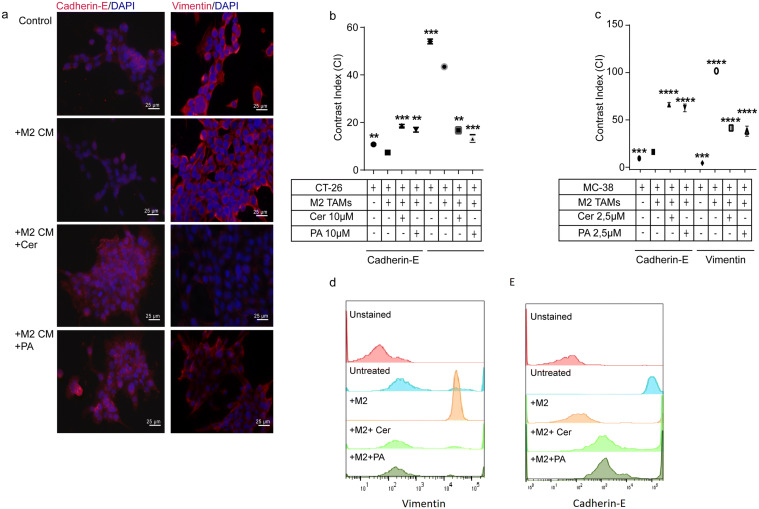Correction to: Molecular and Cellular Biochemistry (2020) 468:153–168 10.1007/s11010-020-03719-5
The third and fifth author's affiliation was published incorrectly in the original article. Also, Fig. 5 and the Acknowledgement section were published incorrectly. The corrected affiliation, Fig. 5 and the Acknowledgement section are provided in this correction.
Fig. 5.
Co-culture of CT-26 cells with M2-polarized tumor-associated macrophages (TAMs) increased the mesenchymal phenotype in colorectal cancer cells. a CT-26 cells were indirectly co-cultured with CM of PA- or Cer-treated (10 μM each) M2-TAMs for 48 h and analyzed by fluorescent microscopy for Cadherin-E (left, purple) and Vimentin (right, purple) expression. The cell nuclei were stained with DAPI (blue). Scale bar = 25 µm. b Quantification of the fluorescent intensity of the Cadherin-E and Vimentin labeling in CT-26 cells upon co-culture with CM of PA- or Cer-treated M2-TAMs. c MC-38 cells were directly co-cultured with M2-TAMs treated that were with PA or Cer (2.5 μM each) for 48 h and analyzed by flow cytometer for d Vimentin and e Cadherin-E expression. All p values were compared to CT-26 cells co-cultured with CM of IL-4-treated RAW 264 as well as compared to MC-38 cells directly co-cultured with IL-4-treated RAW 264 by analysis of variance and Bonferroni's test **p < 0.01, ***p < 0.001 versus M2-TAM CM or M2-TAM
Acknowledgements
We acknowledge support by postdoctoral fellowship from Raimundo Fernandes de Araujo Junior by CAPES 88881.119850/2016 -01. RFAJ and LJC received funding from the MSCA-ITN-2015-ETN Action grant (Grant No. 777682; proposal number: 675743; project: ISPIC). TS was supported by the EU Programs H2020-MSCA-2015-RISE PRISAR [Grant No. 644373] and H2020-MSCA-2017-RISE CANCER [Grant No. 777682]. FB received funding from the EU Program H2020-MSCA-2016-RISE CHARMED [Grant No. 734684]. AC received funding from the EU Programs H2020-WIDESPREAD-2017-Twinning ACORN [Grant No. 807281] and H2020-WIDESPREAD-2018- Twinning SIMICA [Grant No. 852985].
Footnotes
Publisher’s Note
Springer Nature remains neutral with regard to jurisdictional claims in published maps and institutional affiliations.



